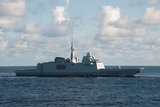US Army awards Q-53 contracts to Lockheed Martin
Lockheed Martin will provide additional Q-53 radar systems to the US Army and enhance its capabilities under three contracts announced by the company on 5 August.
The company will improve the radar’s capabilities, extending its range and enhancing its counter-UAS (C-UAS) surveillance capabilities, as part of work to address emerging threats in the battlefield.
The Q-53 is designed to protect troops in combat by detecting, classifying, tracking and identifying the location of enemy indirect fire in either 90 or 360-degree modes.
Lockheed Martin will deliver 15 Full Rate Production systems under the new contract, bringing the number of systems in the army’s fleet to 189. The Lot 3 systems will continue to be produced using gallium nitride transmit-receive modules. This will provide the radar with additional power, reliability and the possibility for enhanced capabilities including extended range, counterfire target acquisition (CTA) and multi-mission, which delivers simultaneous CTA and air surveillance.
Related Equipment in Defence Insight
More from Digital Battlespace
-
![Babcock nears first customer for Nomad AI translation tool]()
Babcock nears first customer for Nomad AI translation tool
Nomad can provide militaries with real-time intelligence, saving critical time on the battlefield.
-
![AUSA 2025: Israel’s Asio Technologies to supply hundreds of improved Taurus tactical systems]()
AUSA 2025: Israel’s Asio Technologies to supply hundreds of improved Taurus tactical systems
Taurus operates alongside the Israel Defense Forces’ Orion system which supports mission management across tens of thousands of manoeuvring forces, from squad leaders to battalion commanders.
-
![AUSA 2025: Kopin pushes micro-LED plans as China moves faster]()
AUSA 2025: Kopin pushes micro-LED plans as China moves faster
The plan for the new displays follows fresh investment in Kopin’s European facilities by Theon and an order for head-up displays in fielded aircraft, with funding from the US Department of Defense.
-
![AUSA 2025: Persistent Systems to complete its largest order by year’s end]()
AUSA 2025: Persistent Systems to complete its largest order by year’s end
Persistent Systems received its largest ever single order for its MPU5 devices and other systems earlier this month and has already delivered the 50 units to the US Army’s 4th Infantry Division.
-
![Aselsan brings in dozens of companies and systems under the Steel Dome umbrella]()
Aselsan brings in dozens of companies and systems under the Steel Dome umbrella
Turkey has joined the family of countries attempting to establish a multilayered air defence system with government approval in August 2024 for the effort landed by Aselsan. Dubbed Steel Dome, the programme joins Israel’s Iron Dome, the US Golden Dome, India’s Mission Sudarshan Chakra and South Korea’s low-altitude missile defence system.
-
![DSEI 2025: MARSS unveils new agnostic multidomain C4 system]()
DSEI 2025: MARSS unveils new agnostic multidomain C4 system
MARSS’ NiDAR system has been deployed using sensors from static platforms to provide detection and protection for static sights, such as critical infrastructure, ports and military bases.


























